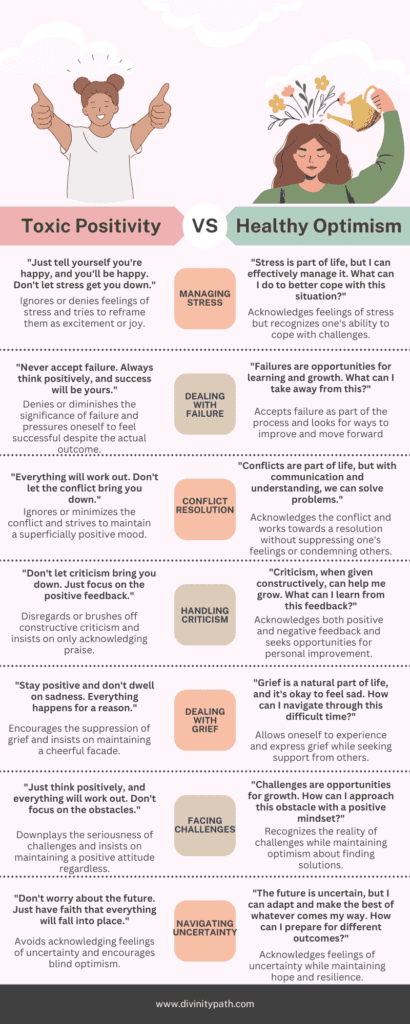Healthy Optimism vs Toxic Positivity -What You Need to Know
In a world where we are constantly bombarded with advice on how to be “positive,” we sometimes find ourselves in a dilemma: is it really necessary to always look on the bright side? Or is it okay to recognize that life is not always full of rainbows and sunny days? The difference between healthy optimism and toxic positivity is often quite thin. Healthy optimism teaches us to seek solutions and growth despite difficulties, while toxic positivity – the “everything will be fine because everything happens for a reason” attitude – often encourages us to suppress our emotions and ignore real challenges.
You’ve probably encountered someone who, in moments of stress, said something like, “Every cloud has a silver lining!” This is not just a sweet illusion; toxic positivity at its best tries to cover up problems with a fake smile. But there’s no room for hiding emotions here. Healthy optimism is accepting the fact that life is sometimes hard, but there’s always room for learning and growth.
Did you know that a study by the Science of People showed that nearly 70% of people experience toxic positivity in the past week? Such words, which deny the validity of difficult feelings, can be more harmful than they appear at first glance. And while this might seem like just another “good piece of advice,” it actually limits our ability to feel truly, authentically – and humanly.
So, what does it actually mean to be optimistically healthy, without suppressing emotions? How can we recognize the difference between healthy optimism and toxic positivity, and how can this difference impact our everyday lives and mental well-being? Let’s explore together.ž

What is Healthy Optimism?
Healthy optimism is not just a genuine smile on your face or the reassurance that says, “Everything will be fine!” And although at first glance it may seem that both healthy optimism and toxic positivity are equally focused on happiness, they are actually two completely different approaches to life. If you want to truly improve your outlook on life, you need to understand the difference between healthy optimism and toxic positivity.
Healthy optimism means the ability to face difficulties and focus on solutions without neglecting or suppressing your emotions. Admitting that things are not always rosy is key. But at the same time, there is strength in this – the strength to find growth in tough moments. It’s the realization that your effort will lead to something better, no matter how hard the current situation may be. This isn’t “comforting,” but a real step forward in finding inner strength.
For example, in the 1970s, American psychologist Martin Seligman began researching the concept of “learned optimism.” He explained that optimism can be learned, but only if we acknowledge the reality of the situations we are in. Healthy optimism is not blind trust, but taking responsibility for your future. Accepting bad days means we will appreciate the good ones when they come.
Signs of Healthy Optimism
Let’s see how healthy optimism manifests in everyday life. It’s not just about looking for the bright side in every situation, but accepting challenges and mistakes as part of the growth process. Healthy optimism encourages you to face challenges instead of ignoring them.
How to Combat Overthinking Before Bed and Fall Asleep Faster
Think of historical figures like Winston Churchill, who was known for his unwavering optimism during the darkest times of World War II. Despite facing enormous challenges, he always believed that the future would be better if we persevered and worked for change.
Taking care of mental health is crucial, as healthy optimism means you’re not afraid to express your emotions. On your worst day, you simply say to yourself, “This too shall pass.” You don’t suppress your sadness, but accept it as a temporary state that will eventually pass. Instead, you ask yourself, “What can I do today to make a step forward?” This approach focuses not just on positive outcomes but on the process of how we’ll move forward through all the ups and downs.
Examples of How Healthy Optimism Reflects in Everyday Language
- “This is tough, but I believe I’ll find a way to overcome it.”
- “Today wasn’t the best day, but that doesn’t mean tomorrow can’t be better.”
- “I accept that I’m having a bad day, but I’ll try to lift myself up.”
- “We all face challenges at times, and that’s completely normal.”
- “Maybe I can take something useful from this situation.”
- “How can I deal with this and find solutions?”
- “I make space for my feelings because they’re part of my journey.”
- “Every failure is an opportunity to learn and grow.”
- “I believe I can learn something new from every situation.”
- “I can focus on the small steps I can take today.”
What is Toxic Positivity?
Now let’s look at what happens when we focus too much on “positive thinking,” no matter what. Toxic positivity convinces us that we must always focus only on the bright side, regardless of how we feel. This can include phrases like: “Stay positive, no matter what.” “Look how happy you must be, life is so beautiful.” “Don’t worry, it’ll pass.”
Of course, these words may be said with good intentions, but they fail to acknowledge the reality of someone’s emotional state. The attempt to suppress emotions can make us even more vulnerable. Holding onto such an approach means we don’t allow ourselves or others to express their pain or uncertainty. When we suppress our emotions, we can feel isolated because we don’t have enough space for genuine communication.
9 Eye-Opening Reasons You Need to Stop Gossiping Right Now
Healthy optimism focuses on feeling and acknowledging our emotions, while toxic positivity forces us to suppress them. As the famous therapist Carl Jung said, “What we do not confront in ourselves will surface in our lives.”
Statements of Toxic Positivity
- “Everything will be okay, just stay positive!”
- “Just look on the bright side, and everything will be better.”
- “Don’t worry, it’s not a big deal.”
- “Try to smile; that will solve all your problems.”
- “Suppress your bad feelings and be grateful for what you have.”
- “Every bad experience is just an opportunity for growth, so don’t complain.”
- “Just think of all the good things in your life.”
- “Stay positive; problems are just in your head.”
- “Just believe, and everything will work out.”
- “Don’t worry; tomorrow is a new day.”
Difference Between Healthy Optimism vs Toxic Positivity
You might be wondering how to distinguish healthy optimism from toxic positivity since they both seem so similar, right? But the difference lies in the approach we have towards our emotions and how we manage them. The first step is to realize that there’s nothing wrong with not feeling happy all the time. Sometimes we simply need to dive into our emotions and truly feel them. And that’s not weakness—it’s strength!
Healthy optimism allows us to recognize negative emotions but not let them define us. For example, if you’re facing challenges at work or in relationships, healthy optimism says, “I see this as a challenge, but that doesn’t mean I’m powerless. Let’s see what I can learn from this situation and how I can move forward.” Healthy optimism encourages us to view challenges as opportunities for growth. In this approach, there is no running from emotions, but instead, an acknowledgment that we are sometimes vulnerable, yet still have the strength to rise and keep going.
What Happens When You’re Too Hard on Yourself, Explained
On the other hand, toxic positivity, despite its good intentions, can lead us to suppress our emotions. For instance, if a friend shares their sadness about struggles at work and we say, “Don’t worry, everything will be fine!”—that may not help. In this case, we don’t allow space for our friend’s emotional expression, which can lead to the feeling that we must always be positive, even when that’s simply impossible.
In fact, when we constantly strive to be “positive” without accepting and addressing our emotional state, we can become anxious and frustrated because we haven’t recognized and embraced the truth about how we feel. The difference between healthy optimism and toxic positivity is not just a word game, but the real ability to recognize when it’s time for a positive outlook and when we simply need to accept that certain moments are tough and we need time to process our feelings.
How to Change Limiting Beliefs That Are Keeping You Stuck in Life









